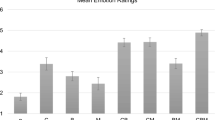Abstract
Eight-year-old children and adult female college students were asked to describe situations in which each of six emotions would be felt (production task) and to judge which emotion would be felt in situations described by other subjects (judgment task). In addition, mothers of the child subjects were asked to judge descriptions generated by their own child and by other children. Data analysis showed that adults and children produced stories that could be classified into the same set of thematic categories. In addition, adults and children could accurately identify the emotion in stories produced by other adults and children. Last, mothers judged descriptions produced by other children as easily as descriptions produced by their own child.
Similar content being viewed by others
References
Arnold, M. B. (1960).Emotion and personality (Vols. 1 & 2). New York: Columbia University Press.
Averill, J. (1982).Anger and aggression. New York: Springer-Verlag.
Barden, R. C., Zelko, F. A., Duncan, S. W., & Masters, J. C. (1980). Children's consensual knowledge about the experiential determinants of emotion.Journal of Personality and Social Psychology, 39 968–976.
Bates, E. (1976). Pragmatics and sociolinguistics in child language. In D. Morehead & A. Morehead (Eds.),Directions in normal and deficient child language. Baltimore: University Park Press.
Borke, H. (1971). Interpersonal perception of young children: Egocentrism or empathy?Developmental Psychology, 5 263–269.
Boucher, J. (1983). Antecedents to emotion across cultures. In S. H. Irvine & J. Berry (Eds.),Human assessment and culture factors (pp. 407–420). New York: Plenum Press.
Boucher, J., & Brandt, M. (1981). Judgment of emotion: American and Malay antecedents.Journal of Cross-Cultural Psychology, 12 272–283.
Bowlby, J. (1973).Attachment and loss, Vol. 2: Separation. New York: Basic Books.
Camras, L. A., & Allison, K. (1985). Children's understanding of emotional facial expressions and verbal labels.Journal of Nonverbal Behavior, 9 84–94.
Darwin, C. (1965).The expression of the emotions in man and animals. Chicago: University of Chicago Press. (Original work published 1872)
Ekman, P. (1977). Biological and cultural contributions to body and facial movement. In J. Blacking (Ed.),Anthropology of the body. London: Academic Press.
Gnepp, J. (1983). Children's social sensitivity: Inferring emotions from conflicting cues.Developmental Psychology, 19 805–814.
Hall, J. (1984).Nonverbal sex differences. Baltimore: Johns Hopkins University Press.
Harris, P. L. (1983). Children's understanding of the link between situation and emotion.Journal of Experimental Child Psychology, 36 490–509.
Harris, P., Guz, G., Lipian, M., & Man-Shu, Z. (1985). Insight into the time-course of emotion among Western and Chinese children.Child development, 56 972–988.
Harter, S. (1982). Children's understanding of multiple emotions. A cognitive-developmental approach. In W. Overton (Ed.),The relationship between social and cognitive development. Hillsdale, NJ: Erlbaum.
Harter, S., & Buddin, B. (1983, April).Children's understanding of the simultaneity of two emotions: A developmental acquisition sequence. Paper presented at the meeting of the Society for Research in Child Development, Detroit.
Izard, C. E. (1972).Patterns of emotion. New York: Academic Press.
Izard, C. E. (1977).Human emotions. New York: Plenum Press.
Lazarus, R., Kanner, A., & Folkman, S. (1980). Emotions: A cognitive-phenomenological analysis. In R. Plutchik & H. Kellerman (Eds.),Emotions: Theory, research and experience (pp. 189–218). New York: Academic Press.
Mandler, G. (1984).Mind and body. New York: W. W. Norton.
Masters, J. C., Barden, C., & Ford, M. E. (1979). Affective states, expressive behavior and learning in children.Journal of Personality and Social Psychology, 37 380–390.
Miller, P., & Sperry, L. (1987). The socialization of anger and aggression.Merrill-Palmer Quarterly, 33 1–31.
Plutchik, R. (1980).Emotion: A psychoevolutionary synthesis. New York: Harper & Row.
Potts, R. (1988).West-side stories: Children's conversational narratives in a black, working-class community. Unpublished manuscript, University of Chicago, Committee on Cognition and Communication.
Reichenbach, L., & Masters, J. (1983). Children's use of expressive and contextual cues in judgments of emotion.Child Development, 54 993–1004.
Scherer, K. (1984a). On the nature and function of emotion: A component process approach. In K. Scherer & P. Ekman (Eds.),Approaches to emotion (pp. 293–317). Hillsdale, NJ: Erlbaum.
Scherer, K. (1984b). Emotion as a multicomponent process: A model and some cross-cultural data. In P. Shaver (Ed.),Review of personality and social psychology (Vol. 5, pp. 37–63). Beverly Hills: Sage.
Scherer, K., Walbott, H., & Summerfield, A. (1986).Experiencing emotion: A crosscultural study. Cambridge: Cambridge University Press.
Seidner, L., & Stipek, D., & Feschbach, N. (1987). A developmental analysis of elementary school-aged children's concepts of pride and embarrassment.Child Development, 59 367–377.
Shaver, P., Schwartz, J., Kirson, D., & O'Connor, C. (1987). Emotion knowledge: Further exploration of a prototype approach.Journal of Personality and Social Psychology, 52 1061–1086.
Stein, N., & Jewett, J. (1986). A conceptual analysis of the meaning of negative emotions: Implications for a theory of development. In C. Izard & P. Read (Eds.),Measuring emotions in infants and children (Vol. 2, pp. 238–267). New York: Cambridge University Press.
Stein, N., & Levine, L. (in press). Thinking about feeling: The development and organization of emotional knowledge. In R. Snow & M. Farr (Eds.),Aptitude, learning and instruction (Vol. 3): Cognition, conation and affect. Hillsdale, NJ: Erlbaum.
Tomkins, S. S. (1963).Affect, imagery, and consciousness (Vols. 1 & 2). New York: Springer.
Trabasso, T., Stein, N., & Johnson, L. (1981). Children's knowledge of events: A causal analysis of story structure. In G. Bower (Ed.),The psychology of learning and motivation (Vol. 15, pp. 237–282). New York: Academic Press.
Uberg, K., & Docherty, E. M. (1976). Development of role-taking skills in young children.Developmental Psychology, 12 198–203.
Umiker-Sebeok, D. J. (1972). Preschool children's intraconversational narratives.Journal of Child Language, 6 51.
Zelko, F., Duncan, S., Barden, R., Garber, J., & Masters, J. (1986). Adults' expectancies about children's emotional responsiveness: Implications for the development of implicit theories of affect.Developmental Psychology, 22 109–114.
Author information
Authors and Affiliations
Additional information
This research was supported by a grant from the DePaul University Faculty Research and Development Committee. The authors wish to thank the children, parents, and staff of the Circle M Daycamp and the New City YMCA.
Rights and permissions
About this article
Cite this article
Camras, L.A., Allison, K. Children's and adults' beliefs about emotion elicitation. Motiv Emot 13, 53–70 (1989). https://doi.org/10.1007/BF00995544
Issue Date:
DOI: https://doi.org/10.1007/BF00995544




